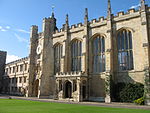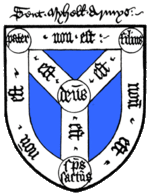St John's Street, Cambridge

St John's Street is a historical street in central Cambridge, England. The street links with Bridge Street, Round Church Street, and Sidney Street to the north. It continues to the south as Trinity Street, then King's Parade and Trumpington Street. This thoroughfare is the main area for some of the most historic University of Cambridge colleges. St John's College is located on the west side of the street, hence the name. The college has an impressive crenellated gatehouse entrance and the tower of the chapel dominates the scene at the north of the street. A medieval church, All Saints Jewry, stood in St John's Street. It was rebuilt in 1820 and then demolished in 1865. The site remains a green space. All Saints is now located in Jesus Lane, to the east. On the east side of the street is the old School of Divinity, built between 1878 and 1879 by Basil Champneys for the Faculty of Divinity on land leased by St John's College. Control of the building reverted to St John's when the faculty of divinity moved to the Sidgwick Site in 2000. The old School of Divinity is now part of the All Saints' Yard of St John's.
Excerpt from the Wikipedia article St John's Street, Cambridge (License: CC BY-SA 3.0, Authors, Images).St John's Street, Cambridge
St John's Street, Cambridge Newnham
Geographical coordinates (GPS) Address Phone number Nearby Places Show on map
Geographical coordinates (GPS)
| Latitude | Longitude |
|---|---|
| N 52.2074 ° | E 0.118 ° |
Address
Le Patissier
St John's Street 11
CB2 1TW Cambridge, Newnham
England, United Kingdom
Open on Google Maps










